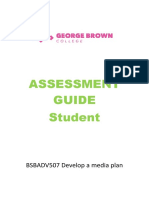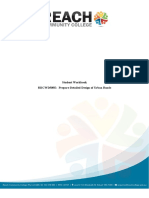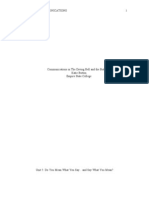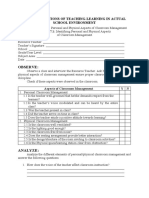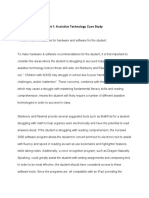BSBHRM506 - Assessment 2
BSBHRM506 - Assessment 2
Uploaded by
AbhisekCopyright:
Available Formats
BSBHRM506 - Assessment 2
BSBHRM506 - Assessment 2
Uploaded by
AbhisekOriginal Title
Copyright
Available Formats
Share this document
Did you find this document useful?
Is this content inappropriate?
Copyright:
Available Formats
BSBHRM506 - Assessment 2
BSBHRM506 - Assessment 2
Uploaded by
AbhisekCopyright:
Available Formats
BSBHRM506
Manage recruitment selection
and induction processes
Unit Assessment Student Pack
BSBHRM506- Student Assessment Pack V2.0 April 2020 Page 0 of 12
Instructions to Student
Assessment instructions
Overview
Prior to commencing the assessments, your trainer/assessor will explain each assessment task and
the terms and conditions relating to the submission of your assessment task. Please consult with
your trainer/assessor if you are unsure of any questions. It is important that you understand and
adhere to the terms and conditions, and address fully each assessment task. If any assessment task
is not fully addressed, then your assessment task will be returned to you for resubmission. Your
trainer/assessor will remain available to support you throughout the assessment process.
Written work
Assessment tasks are used to measure your understanding and underpinning skills and knowledge of
the overall unit of competency. When undertaking any written assessment tasks, please ensure that
you address the following criteria:
Address each question including any sub-points
Demonstrate that you have researched the topic thoroughly
Cover the topic in a logical, structured manner
Your assessment tasks are well presented, well referenced and word processed
Your assessment tasks include your full legal name on each and every page.
Active participation
It is a condition of enrolment that you actively participate in your studies. Active participation is
completing all the assessment tasks on time.
Plagiarism
Plagiarism is taking and using someone else's thoughts, writings or inventions and representing them
as your own. Plagiarism is a serious act and may result in a student’s exclusion from a course. When
you have any doubts about including the work of other authors in your assessment, please consult
your trainer/assessor. The following list outlines some of the activities for which a student can be
accused of plagiarism:
Presenting any work by another individual as one's own unintentionally
Handing in assessments markedly similar to or copied from another student
Presenting the work of another individual or group as their own work
Handing in assessments without the adequate acknowledgement of sources used, including
assessments taken totally or in part from the internet.
BSBHRM506-Student Assessment Pack V2.0 April 2020 Page 1 of 12
If it is identified that you have plagiarised within your assessment, then a meeting will be organised
to discuss this with you, and further action may be taken accordingly.
Collusion
Collusion is the presentation by a student of an assignment as their own that is, in fact, the result in
whole or in part of unauthorised collaboration with another person or persons. Collusion involves
the cooperation of two or more students in plagiarism or other forms of academic misconduct and,
as such, both parties are subject to disciplinary action. Collusion or copying from other students is
not permitted and will result in a “0” grade and NYC.
Assessments must be typed using document software such as (or similar to) MS Office. Handwritten
assessments will not be accepted (unless, prior written confirmation is provided by the
trainer/assessor to confirm).
Competency outcome
There are two outcomes of assessments: S = Satisfactory and NS = Not Satisfactory (requires more
training and experience).
Once the student has satisfactorily completed all the tasks for this module the student will be
awarded “Competent” (C) or “Not yet Competent” (NYC) for the relevant unit of competency.
If you are deemed “Not Yet Competent” you will be provided with feedback from your assessor and
will be given another chance to resubmit your assessment task(s). If you are still deemed as “Not Yet
Competent” you will be required to re-enrol in the unit of competency.
NOTE – Re-assessment:
Students will have a maximum of two (2) reassessment attempts if competency is not achieved in
the first instance.
Additional evidence
If we, at our sole discretion, determine that we require additional or alternative
information/evidence in order to determine competency, you must provide us with such
information/evidence, subject to privacy and confidentiality issues. We retain this right at any time,
including after submission of your assessments.
Confidentiality
We will treat anything, including information about your job, workplace, employer, with strict
confidence, in accordance with the law. However, you are responsible for ensuring that you do not
provide us with anything regarding any third party including your employer, colleagues and others,
that they do not consent to the disclosure of. While we may ask you to provide information or
details about aspects of your employer and workplace, you are responsible for obtaining necessary
consents and ensuring that privacy rights and confidentiality obligations are not breached by you in
supplying us with such information.
Assessment appeals process
BSBHRM506-Student Assessment Pack V2.0 April 2020 Page 2 of 12
If you feel that you have been unfairly treated during your assessment, and you are not happy with
your assessment and/or the outcome as a result of that treatment, you have the right to lodge an
appeal. You must first discuss the issue with your trainer/assessor. If you would like to proceed
further with the request after discussions with your trainer/assessor, you need to lodge your appeal
to the course coordinator, in writing, outlining the reason(s) for the appeal.
Recognised prior learning
Candidates will be able to have their previous experience or expertise recognised on request.
Special needs
Candidates with special needs should notify their trainer/assessor to request any required
adjustments as soon as possible. This will enable the trainer/assessor to address the identified needs
immediately.
Assessment requirements
Assessment can either be:
Direct observation
Product-based methods e.g. reports, role plays, work samples
Portfolios – annotated and validated
Questioning
Third party evidence.
BSBHRM506-Student Assessment Pack V2.0 April 2020 Page 3 of 12
Unit Assessment 2
Assessment type:
Report Writing
Objective: To provide you with an opportunity to show you have the required skills for this unit.
Where applicable, a signed observation by either an approved third party or the assessor will need
to be included in these activities as proof of completion.
This activity will enable you to demonstrate the following skills:
Reading:
o critically evaluates and applies content from a range of complex texts to determine
legislative and business requirements
Writing:
o demonstrates clear writing skills by selecting appropriate conventions and to express
precise meaning relevant to context and audience
Oral Communication:
o draws on a repertoire of open questioning and active listening when seeking feedback
from others
o uses appropriate terminology and non-verbal features to present information and clarify
understanding
Numeracy:
o analyses numerical information to determine employees’ remuneration packages
o makes basic calculations to ensure work output is delivered in a timely manner
Navigate the world of work:
o understands and adheres to relevant organizational policies and procedures
o develops or updates organizational policies to meet organizational objectives
o considers own role in terms of its contribution to broader goals of work environment
Interact with others:
o seeks expert advice and skills training where required
o selects appropriate mode of communication for a specific purpose relevant to own role
o uses effective communication skills to liaise with a range of people across the
organization
Get the work done:
o plans and implements tasks required to deliver timely outcomes, negotiating some key
aspects with others
o monitors implementation of plans and adjusts as necessary
o considers whether and how often others should be involved, using consultative or
collaborative processes as an integral part of the decision-making process
o analyses outcomes of decisions to identify improvement opportunities
o actively identifies systems, devices and applications with potential to meet current and
future needs.
Answer the activity in as much detail as possible, considering your organisational requirements.
BSBHRM506-Student Assessment Pack V2.0 April 2020 Page 4 of 12
A. Read a document listing the organisation’s business needs and suggest what the requirements
for a candidate to fill this role would be.
A Job analysis of thus role clarifies the need and purpose of the new position , timeline
for the whole process and requirements for appointment:
Job Analysis
I. General Details
Date of Review 09/07/2020
Reviewed by: Sujit Sah
Validated by: Director of Coles
Job Title H/C
Classification Level Level 5
Status Full-time
II. Duties and Responsibilities
Developing growth strategies and plans.
Managing and retaining relationships with existing clients.
Increasing client base.
Having an in-depth knowledge of business products and value proposition.
Negotiating with stakeholders.
III. Key skills required
Good communication skills.
Good interpersonal skills.
Good business knowledge.
A good grasp of numbers and the ability to write documents in a professional style.
BSBHRM506-Student Assessment Pack V2.0 April 2020 Page 5 of 12
IV. Personal Attributes Required
Computer literate
Understand of confidentiality and privacy legislation
Profession and positive approach to business
The ability to remain flexible and seek alternative options to problems
B. Write a job offer or rejection letter to a candidate, using appropriate language and style.
Hello sujit
Thank you for taking the time to apply for a crew position with McDonald’s STRAND
NSW.
We have given very careful consideration to your application but, on this occasion, we
have identified another more suitable candidate for the position.
Although you have been unsuccessful on this occasion, McDonald’s is committed to
making the job application process a meaningful one. If the management team at
McDonald’s STRAND NSW indicate that you have the potential to work on certain areas,
these will be listed in the following paragraphs.
If you have already applied to another restaurant, please login to the Careers Portal
using your meeting time id # and password and view My Applications.
Thanks again for your interest in working with McDonald’s STRAND NSW, and we truly
wish you all the best!
Kind Regards
Robert
BSBHRM506-Student Assessment Pack V2.0 April 2020 Page 6 of 12
C. Seek feedback from an employee involved in the induction process. Use open questioning and
active listening to identify at least two areas you can improve on.
Example of open questioning to identify areas given in the following:
would you improve the induction process?
Was there any missing information from it?
Answering them with yes or no.
Example of active listening feedback to identify areas are given in the following:
Did the induction provide the worker with the information needed to start work
immediately?
Did the induction miss any areas?
Were you happy with your level of involvement in the induction process?
D. Working with a remuneration specialist, calculate a new employee’s remuneration package.
Following is the example of the remuneration of nursing unit working full time :
-Ordinary hours of work
- ordinary hours of work will be 38 full times hours per week,plus any reasonable additional
hours that are necessary to fulfill the duties or as otherwise required by the employer .
ordinary hours of work may be average over a 4- week period.
Remuneration
- The employee will be paid weekly at the rates of $36.87per hours
- The employer will also make superannuation payments on your behalf in accordance with
the superannuation guarantee (administration)Act 1992.
The remuneration will be reviewed annually and maybe increased at the employer’s
discretion.
Leave
- The staff is entitled to leave(e.g annual leave ,personal leave , career leave , compassionate
leave ,parental leave ,community service leave and long service leave) in accordance with
the nurses and midwives (NSW public heath sectors ) EBA 2016-2020 and the national
employment standards
E. Read your organization objectives and suggest one update to an induction/recruitment policy
in order to meet this.
Relevant legislation may include:
The Age Discrimination Act (2004)
The Sex Discrimination Act (1984)
BSBHRM506-Student Assessment Pack V2.0 April 2020 Page 7 of 12
The Disability Discrimination Act (1992)
The Australian Human Rights Commission Act (1986).
I work in Woolworth as a human resources manager. According to the organization policies
of my organization I follow the following organization policies in managing recruitment and
selection process. These are:
Demonstration of customer service skills.
Face to Face interview
Group interview or peer assessment.
Numerical ability testing
Personality testing
Re free reports.
Due to recent COVID pandemic it is not possible to check a candidate for face to face
interview, peer assessments and personality testing.
That's why according to the change organizational policy I have ti conduct face to face
interview and personality testing through zoom online participation of the interviewees.
Following are the checklist shows of a recruitment and selection process that happened in
my organization Woolworth for the post of customer services executive.
Candidate Response Method of contact Completed date
rame Unconditional Job Method of contact Date completed
offer
sandy Rejection suggesting letter Post the hard copy
another job letter on 15/7/2020
posted the hard
copy letter on
1/7/2020
Birendra Rejection phone made phone call on
20/7/2020
Mahendra Rejection Email Candidate opted for
the electronic
communication.
An email was send
for the rejection on
25/7/2020
Ways to improve :
-The whole selection result could have been published in online.
BSBHRM506-Student Assessment Pack V2.0 April 2020 Page 8 of 12
Those interviewee with rejection could have been sent paper version of the letter.
-Harry and Michel could have been contacted through phone call advising of their rejection.
F. With another student, role-play a scenario in which they are a co-worker you are clarifying
information with. Use effective communication skills to achieve the goal.
The communication process
The goal of communication is to convey information-and the understanding of that
information -from one person to another person. The other important features id the
feedback cycle when two people interact, communication is rarely one-way only. When
a person receive a messages, she respond to it by giving a reply.
The critical factor in measuring the effectiveness of communication is common
understanding .understanding exists when all parties involved have a mutual agreement
as to not only the information,but also meaning of the information.
Non verbal communication
its consists of actions ,gestures, and other aspects of physical appearance that combined
with facial expressions(such as smiling or frowning), can be powerful means of
transmitting messages. At times.a person body may be talking even as he or she
maintains silence. And when people do speak their bodies may sometimes say different
things than their words convey.
Oral communication skills
Because a large part of a manager day is spent conversing with other manager and
employee, the abilities to speak and listen are critical to success. For example oral
communication skills are used when a manager must make sales presentation, conduct
interviews,perform employee evaluations, hold press conferences.
In general managers prefer to reply on oral communication skills because
communication tends to be more complete and through when talking inperson . In face
-to face interactions, person can judge how the other party is reacting ,get immediate
feedback and answer questions. In general ,people tend to assume that talking to
someone directly is more credible than receiving a written message face to – face
communication permits not only the exchange of words, but also the opportunity too
see the nonverbal communication.
Active listening
listening is making sense of what is heard and requires paying attention, interpreting and
remembering sound stimuli. Effective listening is a active, require the hearer to get
BSBHRM506-Student Assessment Pack V2.0 April 2020 Page 9 of 12
inside the head of the speaker so that he or she can understand the communication
from the speakers point of view . Effective listener do the following :
make an eye contact
Schedule sufficient ,uninterrupted time for meeting .
Genuinely seek information.
Avoid being emotional or attack others.
Ask clarifying questions.
Avoid making distracting gestures.
G. Identify the outcome of a decision you have made recently and how it could have been
improved.
The outcome of a decision that I made are good and satisfactory. I believe the updates
made in recruitment selection and induction policies will help the organizz ation to maintain
the human resource of the organization both effectively and efficiently.
BSBHRM506-Student Assessment Pack V2.0 April 2020 Page 10 of 12
You might also like
- Meeting the Assessment Requirements of the Award in Education and TrainingFrom EverandMeeting the Assessment Requirements of the Award in Education and TrainingNo ratings yet
- A Concise Etymological Dictionary of The English Language 1000228636100% (4)A Concise Etymological Dictionary of The English Language 1000228636694 pages
- SOEMM TAEASS504 Summative Assessment (2) - 1No ratings yetSOEMM TAEASS504 Summative Assessment (2) - 113 pages
- BSBWOR502 Lead and Manage Team Effectiveness: Learner WorkbookNo ratings yetBSBWOR502 Lead and Manage Team Effectiveness: Learner Workbook39 pages
- Keeba Choden Graded Satisfactory BSBCMM511 08-09-2023No ratings yetKeeba Choden Graded Satisfactory BSBCMM511 08-09-202337 pages
- Probin Gurung Graded Satisfactory BSBCMM511 08-09-2023No ratings yetProbin Gurung Graded Satisfactory BSBCMM511 08-09-202331 pages
- RIICWD510E Prepare Detailed Design of BuswaysNo ratings yetRIICWD510E Prepare Detailed Design of Busways69 pages
- BSBCMM511 Communicate With Influence SAPNo ratings yetBSBCMM511 Communicate With Influence SAP27 pages
- Assessment Guide Student: BSBADV507 Develop A Media PlanNo ratings yetAssessment Guide Student: BSBADV507 Develop A Media Plan36 pages
- Manage Project Information and Communication (Assignment)No ratings yetManage Project Information and Communication (Assignment)32 pages
- BSBTWK502 Student Assessment Tasks (Task 1)0% (1)BSBTWK502 Student Assessment Tasks (Task 1)11 pages
- BSBPMG411 Learner Assessments (Summative) V1.2No ratings yetBSBPMG411 Learner Assessments (Summative) V1.222 pages
- Student Workbook RIICWD507D: Prepare Detailed Geotechnical DesignNo ratings yetStudent Workbook RIICWD507D: Prepare Detailed Geotechnical Design22 pages
- BSBFIN501 Assessment - Jing Nin.g - Remarked 30062024No ratings yetBSBFIN501 Assessment - Jing Nin.g - Remarked 3006202463 pages
- BSBTWK502 Student Assessment Tasks (Task 1)No ratings yetBSBTWK502 Student Assessment Tasks (Task 1)14 pages
- BSBWHS616 Student Assessment Tasks (Task 1) WorkingNo ratings yetBSBWHS616 Student Assessment Tasks (Task 1) Working17 pages
- BSBWHS616 Student Assessment Tasks (Task 1)No ratings yetBSBWHS616 Student Assessment Tasks (Task 1)16 pages
- Dibesh Manandhar Graded Satisfactory BSBPMG634 11-09-2023No ratings yetDibesh Manandhar Graded Satisfactory BSBPMG634 11-09-202364 pages
- BSBLDR523 Assessment Task Answer - Paper and Question - Paper OrigNo ratings yetBSBLDR523 Assessment Task Answer - Paper and Question - Paper Orig30 pages
- Tlia 5058 Case Study Questions 11-03-2020docx-1No ratings yetTlia 5058 Case Study Questions 11-03-2020docx-137 pages
- Philippine College of Science and Technology: Learner 'S First Activity Ge122 (Purposive Communication) InstructionsNo ratings yetPhilippine College of Science and Technology: Learner 'S First Activity Ge122 (Purposive Communication) Instructions2 pages
- Video Who Is The Responsible Corporation - A Multimodal Analysis OflNo ratings yetVideo Who Is The Responsible Corporation - A Multimodal Analysis Ofl57 pages
- CON101 Assignment 3: Network Security: Satyam Kumar Modi December 2020No ratings yetCON101 Assignment 3: Network Security: Satyam Kumar Modi December 20202 pages
- Wireless Communication & Networking Lab Online Mode Plan-2020No ratings yetWireless Communication & Networking Lab Online Mode Plan-20201 page
- Unit-5 Cybersecurity: Organizational Implications: IV-II SEM CSE, Cyber Security Unit - VNo ratings yetUnit-5 Cybersecurity: Organizational Implications: IV-II SEM CSE, Cyber Security Unit - V13 pages
- Role of The Media in Politics: SUMMER 2020 POL 101: Session 15 (NHA)No ratings yetRole of The Media in Politics: SUMMER 2020 POL 101: Session 15 (NHA)24 pages
- FS 1-LE 7-Physical and Personal Aspects of Classroom ManagementNo ratings yetFS 1-LE 7-Physical and Personal Aspects of Classroom Management5 pages
- Edtc 625 Assistive Technology AssignmentNo ratings yetEdtc 625 Assistive Technology Assignment9 pages
- Meeting the Assessment Requirements of the Award in Education and TrainingFrom EverandMeeting the Assessment Requirements of the Award in Education and Training
- A Concise Etymological Dictionary of The English Language 1000228636A Concise Etymological Dictionary of The English Language 1000228636
- BSBWOR502 Lead and Manage Team Effectiveness: Learner WorkbookBSBWOR502 Lead and Manage Team Effectiveness: Learner Workbook
- Keeba Choden Graded Satisfactory BSBCMM511 08-09-2023Keeba Choden Graded Satisfactory BSBCMM511 08-09-2023
- Probin Gurung Graded Satisfactory BSBCMM511 08-09-2023Probin Gurung Graded Satisfactory BSBCMM511 08-09-2023
- Assessment Guide Student: BSBADV507 Develop A Media PlanAssessment Guide Student: BSBADV507 Develop A Media Plan
- Manage Project Information and Communication (Assignment)Manage Project Information and Communication (Assignment)
- Student Workbook RIICWD507D: Prepare Detailed Geotechnical DesignStudent Workbook RIICWD507D: Prepare Detailed Geotechnical Design
- BSBFIN501 Assessment - Jing Nin.g - Remarked 30062024BSBFIN501 Assessment - Jing Nin.g - Remarked 30062024
- BSBWHS616 Student Assessment Tasks (Task 1) WorkingBSBWHS616 Student Assessment Tasks (Task 1) Working
- Dibesh Manandhar Graded Satisfactory BSBPMG634 11-09-2023Dibesh Manandhar Graded Satisfactory BSBPMG634 11-09-2023
- BSBLDR523 Assessment Task Answer - Paper and Question - Paper OrigBSBLDR523 Assessment Task Answer - Paper and Question - Paper Orig
- Philippine College of Science and Technology: Learner 'S First Activity Ge122 (Purposive Communication) InstructionsPhilippine College of Science and Technology: Learner 'S First Activity Ge122 (Purposive Communication) Instructions
- Video Who Is The Responsible Corporation - A Multimodal Analysis OflVideo Who Is The Responsible Corporation - A Multimodal Analysis Ofl
- CON101 Assignment 3: Network Security: Satyam Kumar Modi December 2020CON101 Assignment 3: Network Security: Satyam Kumar Modi December 2020
- Wireless Communication & Networking Lab Online Mode Plan-2020Wireless Communication & Networking Lab Online Mode Plan-2020
- Unit-5 Cybersecurity: Organizational Implications: IV-II SEM CSE, Cyber Security Unit - VUnit-5 Cybersecurity: Organizational Implications: IV-II SEM CSE, Cyber Security Unit - V
- Role of The Media in Politics: SUMMER 2020 POL 101: Session 15 (NHA)Role of The Media in Politics: SUMMER 2020 POL 101: Session 15 (NHA)
- FS 1-LE 7-Physical and Personal Aspects of Classroom ManagementFS 1-LE 7-Physical and Personal Aspects of Classroom Management
































